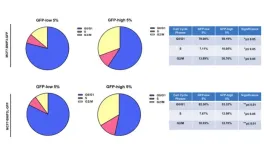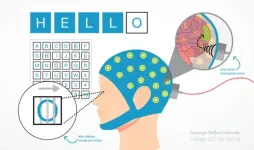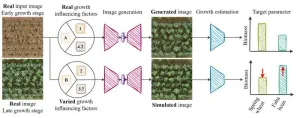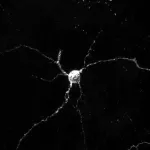(Press-News.org) A new aging atlas gives scientists an in-depth view of how individual cells and tissues in worms age and how different lifespan-extending strategies might stop the clock.
Aging impacts all the tissues in our body – from our muscles to our skin. Figuring out how individual tissues and cells age could help researchers better understand the aging process and aid in the development of anti-aging treatments.
Due to their short lifespans, simple body plans, and genetic similarity to humans, many researchers study aging in roundworms. To look at aging at the level of tissues and cells, a team of researchers from HHMI's Janelia Research Campus, Baylor College of Medicine, and Creighton University School of Medicine profiled gene expression in each cell of adult roundworms at different times during the aging process. They also profiled long-lived strains of worms.
The researchers compiled their results into a complete transcriptomic cell atlas of aging in roundworms. The open-access atlas allows scientists to look at what genes are being expressed in all the worm’s cells at the same time and how gene expression changes over time, both for wildtype worms and worms with extended lifespans.
Using the atlas, the researchers developed tissue-specific “aging clocks,” predictive models they used to tease out the unique aging features of different tissues. The researchers used these clocks to better understand the anti-aging mechanisms in long-lived strains of worms.
The researchers also built the first germ cell fate trajectory map that follows how reproductive cells develop over time, enabling the team to discover age-related changes in cell makeup and gene expression in different stages of reproductive cells.
The atlas also allowed the team to get a view of polyadenylation, a key mechanism for gene regulation and protein diversification, across the entire worm as it aged. They discovered a series of age-related changes in these events in different cell types, suggesting a previously unknown link between this mechanism and aging.
The new findings not only give researchers insight into aging on the molecular level, but the new open-access atlas and accompanying user-friendly data portal also serve as a resource for other researchers.
END
New ‘aging atlas’ provides a detailed map of how cells and tissues age
2024-06-17
ELSE PRESS RELEASES FROM THIS DATE:
New technology allows researchers to precisely, flexibly modulate brain
2024-06-17
By Beth Miller
Human brain diseases, such as Parkinson’s disease, involve damage in more than one region of the brain, requiring technology that could precisely and flexibly address all affected regions simultaneously. Researchers at Washington University in St. Louis have developed a noninvasive technology combining a holographic acoustic device with genetic engineering that allows them to precisely target affected neurons in the brain, creating the potential to precisely modulate selected cell ...
Origins of cumulative culture in human evolution
2024-06-17
Each of us individually is the accumulated product of thousands of generations that have come before us in an unbroken line. Our culture and technology today are also the result of thousands of years of accumulated and remixed cultural knowledge.
But when did our earliest ancestors begin to make connections and start to build on the knowledge of others, setting us apart from other primates? Cumulative culture — the accumulation of technological modifications and improvements over generations — allowed humans to adapt to a diversity of environments and challenges. But, it is unclear when cumulative culture first developed during hominin evolution.
A study published ...
Mitophagy and cancer: BNIP3/BNIP3L’s role in stemness, ATP production, proliferation, and cell migration
2024-06-17
“[...] our current work has provided a novel strategy to enrich for a sub-population of cancer cells, with high basal levels of mitophagy.”
BUFFALO, NY- June 17, 2024 – A new research paper was published on the cover of Aging (listed by MEDLINE/PubMed as "Aging (Albany NY)" and "Aging-US" by Web of Science) Volume 16, Issue 11, entitled, “Mitophagy and cancer: role of BNIP3/BNIP3L as energetic drivers of stemness features, ATP production, proliferation, and cell migration.”
Mitophagy is a selective form of autophagy which permits ...
Breakthrough approach enables bidirectional BCI functionality
2024-06-17
Brain-computer interfaces or BCIs hold immense potential for individuals with a wide range of neurological conditions, but the road to implementation is long and nuanced for both the invasive and noninvasive versions of the technology. Bin He of Carnegie Mellon University is highly driven to improve noninvasive BCIs, and his lab uses an innovative electroencephalogram (EEG) wearable to push the boundaries of what’s possible. For the first time on record, the group successfully integrated a novel focused ultrasound stimulation to realize bidirectional BCI that both encodes and decodes brain waves using machine learning in a study with 25 human subjects. This work opens ...
Polarization and risk perception could play important roles in climate-policy outcomes
2024-06-17
Times of crises often call for strong and rapid action, but in polarized societies, strong top-down policies can backfire.
In a paper published on June 17, 2024, in Environmental Research Letters, SFI Applied Complexity Fellow Saverio Perri, SFI Science Board Fellow Simon Levin (Princeton University), and colleagues present a conceptual model of how these dynamics could play out in efforts to decarbonize our energy supply. The model illustrates the complex interplay between strong policies, people’s perception of risk, and the amount of polarization in a society. They show that in situations where the perception of risk is low — where the ...
AI shows how field crops develop
2024-06-17
Researchers at the University of Bonn have developed software that can simulate the growth of field crops. To do this, they fed thousands of photos from field experiments into a learning algorithm. This enabled the algorithm to learn how to visualize the future development of cultivated plants based on a single initial image. Using the images created during this process, parameters such as leaf area or yield can be estimated accurately. The results have been published in the journal Plant Methods.
Which plants should I combine ...
African research funders in global spotlight through Dimensions indexing project
2024-06-17
African research is receiving a major visibility boost with the indexing of 10 national funders in Dimensions, the world’s largest linked research database.
This project is a collaboration with Digital Science, the Africa PID Alliance (APA), the Association of African Universities (AAU), the Training Centre in Communication (TCC Africa), and the Research Organization Registry (ROR).
“This project connects the research outputs from leading African funding bodies to the global research ecosystem,” said Joy Owango, Executive Director of TCC Africa ...
New study suggests cancer drug could be used to target protein connection that spurs Parkinson’s disease
2024-06-17
FOR IMMEDIATE RELEASE
In studies with genetically engineered mice, Johns Hopkins Medicine researchers say they have identified a potentially new biological target involving Aplp1, a cell surface protein that drives the spread of Parkinson’s disease-causing alpha-synuclein.
The findings, published May 31 in Nature Communications, reveal how Aplp1 connects with Lag3, another cell surface receptor, in a key part of a process that helps spread harmful alpha-synuclein proteins to brain cells. Those protein buildups are hallmarks of Parkinson’s disease.
Notably, the researchers say, Lag3 is already the target of a combination ...
More than 1 in 10 patients at FQHCs experience major social risk factors
2024-06-17
A first-of-its-kind study found high rates of food insecurity, housing insecurity, financial strain, and/or a lack of transportation among patients at federally qualified health centers, particularly patients who were low-income or from racial/ethnic minority populations.
Federally qualified health centers (FQHCs) offer primary care services to 1 in 11 Americans, the majority of whom are low-income and/or underinsured and may not otherwise receive this care. While prior research has shown that 70 percent of FQHCs screen for social ...
Artificial intelligence accurately screens heart failure patients for clinical trial eligibility
2024-06-17
Generative Artificial Intelligence (Gen AI) can rapidly and accurately screen patients for clinical trial eligibility, according to a new study from Mass General Brigham researchers. Such technology could make it faster and cheaper to evaluate new treatments and, ultimately, help bring successful ones to patients.
Investigators assessed the accuracy and cost of a Gen AI process they named RAG-Enabled Clinical Trial Infrastructure for Inclusion Exclusion Review (RECTIFIER), that identifies patients who meet criteria for enrollment in ...




